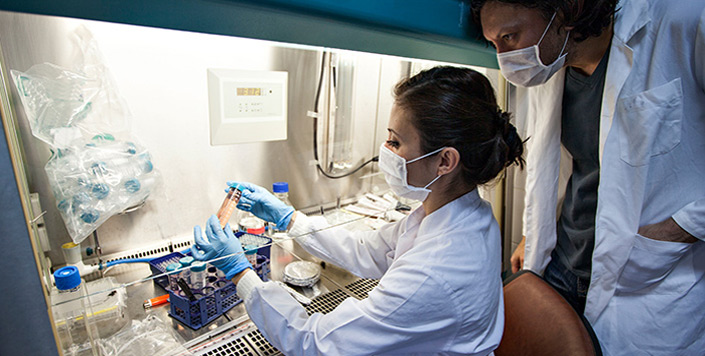
School of Medicine Publications and Presentations
Document Type
Conference Proceeding
Publication Date
7-2019
Abstract
Purpose: The aim for this study is to investigate the expression of integrin α3, β1 and TGF-β induced protein (TGFBI) and the secretion of TGFBI by primary culture of human retinal pericytes (pHRP). Evidence suggests that chronic diabetes associate with HRP apoptosis leading to the development of diabetic retinopathy.
Methods: pHRP (Cell Systems) were cultured in complete media (15mM glucose) in a humidified, 5% CO2, 37°C condition. Cells were seeded at passage 6 to 8 into a 24 well-plate with coverslips or P10 dishes. Cells (85% confluence) media were then replaced by DMEM media with euglycemic glucose (5.5mM) or hyperglycemic glucose (30mM) and cells were incubated for 48 or 72 hours. Gene and protein expressions of α3, β1 were detected by Real-Time PCR and flow cytometry. TGFBI gene expression was detected by Real-Time PCR and ELISA was used to measure protein level in cell media.
Results: Real-Time PCR showed expression of α3, β1 and TGFBI in pHRP at 48 hrs of incubation in both glucose concentrations. Expression of a3 in pHRP in 30 mM glucose was 1.3 times higher than cells in 5.5mM glucose whereas expressions of b1 and TGFBI were comparable in two glucose concentrations. Flow cytometry results also showed expression of integrin subunits in pHRP at 72 hr of incubation. Expression of a3 in pHRP in 30mM glucose was similar to those in cells in 5.5m M (MFI of 251 vs 221 respectively). However, expression of b1 was higher in cells in the higher glucose concentration (MFI: 422 vs 343). ELISA data showed secretion TGFBI protein by HRP at 48 hr of incubation. Protein concentration in media of cell in 30mM glucose was significantly higher than those in 5.5mM (97 vs 57 pg/ml; p=0.0318).
Conclusions: This is the first report on the expression of integrin subunits in HPR in euglycemic and hyperglycemic conditions. Both RT-PCR and flow cytometry results show α3, β1 subunits expressions, the level of which may be affected by glucose concentration in the cell media. Furthermore, our ELISA results confirm the secretion of TGFB1 by HRP and a significantly higher protein secretion in hyperglycemic condition. Overall, our data support the hypothesis of integrin and TGFBI expression in HRP. The increase in TGFBI secretion in hyperglycemia suggest a possible role of diabetes. Further studies will provide insight into the role of integrin and TGFBI interaction on the signaling pathway of HRP apoptosis and diabetic retinopathy.
Recommended Citation
Andrew T C Tsin, Brenda Su, Laura Valdez, Edgar Serrato; Expression of Integrin and TGFBI in Human Retinal Pericytes. Invest. Ophthalmol. Vis. Sci. 2019;60(9):2662.
Creative Commons License

This work is licensed under a Creative Commons Attribution-NonCommercial-No Derivative Works 4.0 International License.
Publication Title
Investigative Ophthalmology & Visual Science
Academic Level
faculty
Mentor/PI Department
Neurology


Comments
Original published version available at https://iovs.arvojournals.org/article.aspx?articleid=2742715&resultClick=1